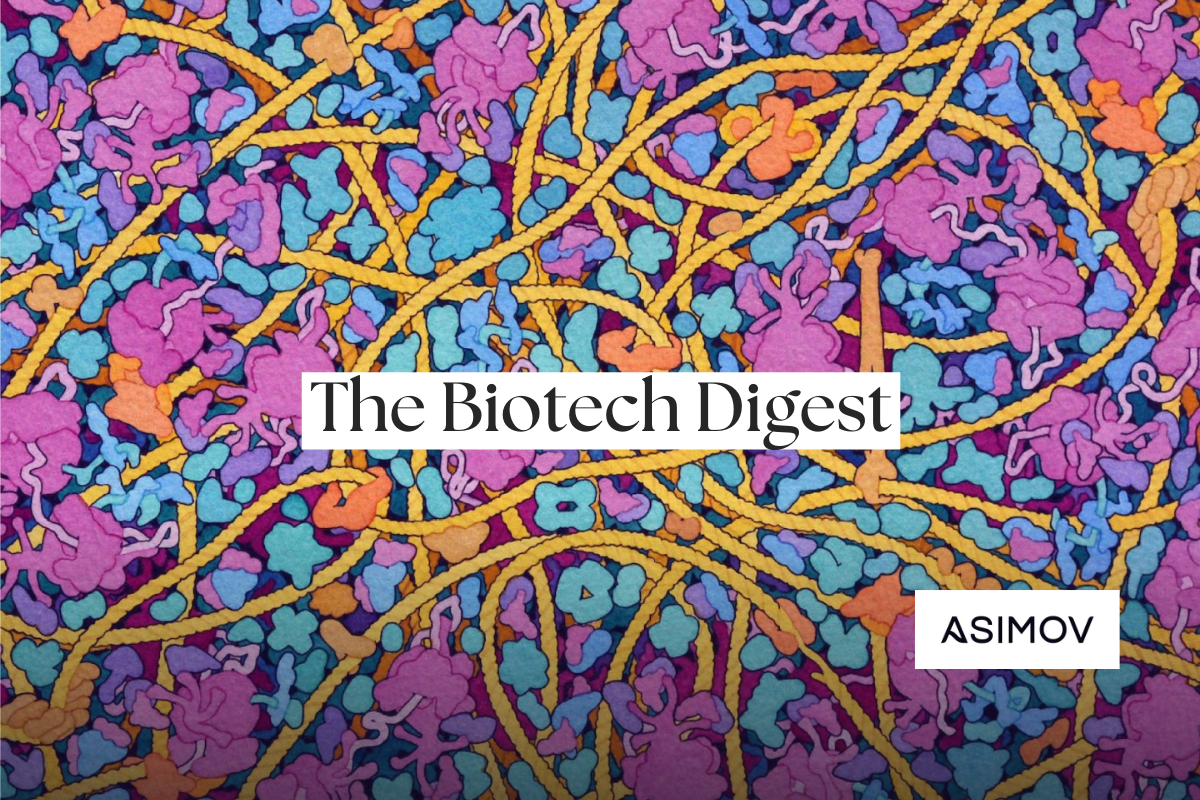The Biotech Digest No. 2
We’re launching a weekly digest to highlight recent papers and news in biotechnology. This is the second edition. Please send feedback to niko@asimov.com.
Where Do Biologists Share Their Work? Twitter.
Look, I’m annoyed by Twitter just as much as the next guy. The news feed is swiftly evolving into TikTok. The algorithm has almost completely nerfed links, which makes it difficult to share articles, blogs, and papers. There is an increasing preponderance of tweets that say “Link in Bio.”
Despite my antipathy towards Twitter, though, a recent study suggests that links to biology papers still show up there more often than on Facebook, Wikipedia, conventional news websites, or blogs. A group of Spanish authors figured this out using altmetrics data, which is basically a way to track how often papers are mentioned or shared across other websites. They analyzed more than 3.5 million mentions of ~240,000 papers that had at least one Spanish author and were published between 2016-2020. They pulled out the top authors from several different fields, including molecular biology, clinical medicine, space sciences, and environmental sciences, and then tracked how often their articles appeared on the different platforms.
Molecular biology articles were mostly shared on Twitter. Space sciences is more popular on blogs, and clinical medicine is popular across nearly every channel. Neuroscience, surprisingly, is very popular on Facebook. I’d be curious to know if these numbers have shifted since 2020—my guess would be “yes.” But as scientists leave Twitter, where are they migrating to have fruitful conversations?
Also, Matt Clancy over at New Things Under the Sun published a blog yesterday about where scientists share their ideas (h/t Jason Crawford). It’s worth a read. (One correlation in the data: Papers that get more tweets, even from the same journal—like PLOS One—tend to get more citations.)
Cheaper Weight-Loss Drugs Are Coming
China and India are ramping up biosimilar manufacturing for GLP-1 drugs, according to a news story in Nature. The market for these diabetes and weight-loss drugs is expected to exceed $100 billion by 2030.
These drugs work by mimicking a hormone that the body naturally makes, called glucagon-like peptide 1 (GLP-1). These molecules bind to GLP-1 receptors in the pancreas, which helps regulate blood sugar levels and tells the brain to stop eating. The F.D.A. approved a version of these drugs for weight-loss in 2014, called liraglutide. An improved variant called semaglutide—which helps people lose even more weight—was approved in 2021. Tirzepatide, which is sold by Eli Lilly as Zepbound, was approved in 2023.
A month’s worth of these drugs usually costs more than $1,000. But large factories in China and India are quickly ramping up their biosimilars manufacturing. This passage from the Nature article is particularly striking: “No weight-loss biosimilars have yet been approved in India, but Glenmark Pharmaceuticals in Mumbai, India, launched Lirafit, a liraglutide biosimilar, in January for treating type 2 diabetes. Glenmark said in a press release that, at some 100 rupees a day (US$1.20), Lirafit costs 70% less than existing therapies.” Liraglutide helps people lose about 8% body weight after one year.
The patent for liraglutide already expired in China, and semaglutide’s patent expires in 2026 in both China and India. But there are also many more weight-loss drugs in late-stage clinical trials. Early data for a molecule called retatrutide, now in phase 3, suggests it helps people lose even more weight than tirzepatide. In a few years, there will likely be several options for people to lose weight, and many of them will be cheap to buy.
Towards a 57-Codon E. coli
George Church’s laboratory at Harvard is trying to make an E. coli cell that has just 57 codons, instead of the normal 64. I’ve been looking forward to this paper for years. I remember hearing about it for the first time as a masters student at Imperial College London, way back in 2017 or 2018. At the time, I thought the project would be done by now—but, alas, biology is difficult.
The genetic code is degenerate, because a single amino acid can be coded for by multiple different codons. In E. coli, for example, the codons “UUA” and “UUG” both code for leucine (as do four other codons that I didn’t even mention.) So the idea is that, by removing some of these redundant codons, it is possible for cells to code for unnatural amino acids instead—molecules not included in the normal batch of 20. A re-coded cell would be able to make proteins with new chemical or physical properties; molecules with an expanded chemical repertoire. This is potentially very useful for drug manufacturing.
Unfortunately, a 57-codon E. coli is still a long way away. The seven codons that they’re trying to remove show up in 62,007 places in the genome. And all of them need to be removed. In this paper, the researchers synthesized 89 chunks of the genome—with the codons removed—and tried to stick them together. They also invented a new method, called SynOMICS, to replace the genome—step by step—with recoded, synthetic DNA. But as this work progressed, the cells went totally haywire. Their fitness levels went way down (meaning they look sickly and grow slowly) and their gene expression started to get wonky. Thousands of genes in the re-coded organism had “differential gene expression,” which basically means they are behaving differently compared to the wildtype cells.
In this paper, the researchers assembled just 39 percent, or 1.55 million bases of DNA, of the re-coded genome. It took them 210 rounds of genome-editing and 1,120 days of laboratory evolution. The estimated project cost is about $3.2 million. And the road ahead is long and winding…

Papers You Might Have Missed
(* = Recommended)
Ground-up microbes can be used as a liquid egg replacement? NPJ Science of Food
*“Evolution-informed” protein design makes a functional TEM-1 β-lactamase that is 84 mutations away from the nearest natural homolog. Nature Communications
*Computational design of soluble and functional membrane proteins. Nature
A method to map protein interactions in cells. Nature Biomedical Engineering
*Troubleshooting protein expression in a cell-free E. coli system. bioRxiv
High-resolution imaging of brain synapses. Nature Methods
Using engineered Glut1 protein to target other proteins to the lysosome. JACS
*DNA replication speeds are not constant, but accelerate during the S phase of cell division. Nature Methods
Single point mutations that make Salmonella Typhi hypervirulent. Nature Communications
Blood-based biomarkers for Plasmodium gametocyte production. eBioMedicine
A new tool to control the subcellular locations of proteins. Nature Chemical Biology
PhagePromoter, an ML tool to identify loci in phages “with favorable expression levels” to help with engineering. bioRxiv
*In vitro reconstitution of actomyosin rings for synthetic cell division. bioRxiv
A protocol for single-cell bacterial transcriptomics. Nature Protocols
Transplanting microglial cells from one brain to another protects against pathologies. Neuron
Immune imprinting update for influenza B. Nature Microbiology
Sparrow, an algorithm that decides which molecules to make (for drugs, etc.) “by balancing expected information gain and synthetic cost.” Nature Computational Science
Different methods to quantify DNA lead to wildly different results. PLOS One
Single-molecule nanopore sequencing can measure the pKa of individual moieties along a polymer. Nucleic Acids Research
Coaxing microbial communities to work better together. Nature Microbiology
*Evolution of rove beetle biosynthesis pathways. Cell
A newly discovered molecular mechanism that phages use to overcome bacterial defenses. Nature Microbiology
Using satellites + AI to monitor crops. Molecular Plant
In Other News…
Grants for programs focused on health in low- or middle-income countries. LinkThe F.D.A., after criticisms, will hold fewer advisory committee votes. In the Pipeline
How to pay for individualized genetic medicines. Nature Medicine
Trees growing thousands of miles apart synchronize their fruiting with the sun. Quanta
House bill would ban the Department of Defense “from funding any university that has a research collaboration with China.” Science
Wolbachia-infected mosquitoes are being released in Hawaii to protect birds. NPR
Ranking how “open source” AI models that claim to be “open source” actually are. Nature
Cees Dekker, a biophysicist at Delft University of Technology, is building synthetic cells capable of cell division. The Scientist
An ancient Egyptian beer recipe for the modern era. The New York Times
Oldest wine ever discovered in liquid form (it’s Roman). The Guardian



